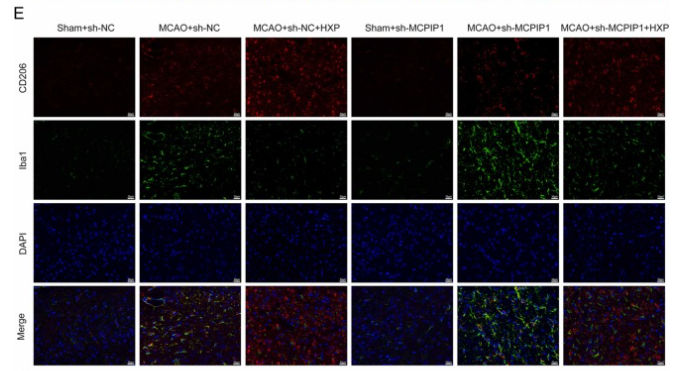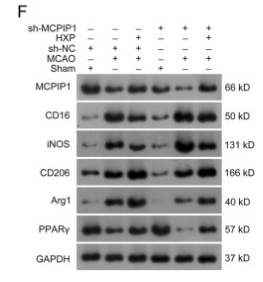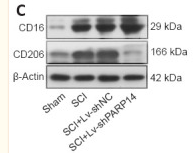MRC1/CD206 Antibody - #DF4149
| Product: | MRC1/CD206 Antibody |
| Catalog: | DF4149 |
| Description: | Rabbit polyclonal antibody to MRC1/CD206 |
| Application: | WB IHC IF/ICC |
| Cited expt.: | WB, IHC, IF/ICC |
| Reactivity: | Human, Mouse, Rat |
| Prediction: | Pig, Bovine, Horse, Sheep, Rabbit, Dog |
| Mol.Wt.: | 166 KD; 166kD(Calculated). |
| Uniprot: | P22897 |
| RRID: | AB_2836514 |
Related Downloads
Protocols
Product Info
*The optimal dilutions should be determined by the end user. For optimal experimental results, antibody reuse is not recommended.
*Tips:
WB: For western blot detection of denatured protein samples. IHC: For immunohistochemical detection of paraffin sections (IHC-p) or frozen sections (IHC-f) of tissue samples. IF/ICC: For immunofluorescence detection of cell samples. ELISA(peptide): For ELISA detection of antigenic peptide.
Cite Format: Affinity Biosciences Cat# DF4149, RRID:AB_2836514.
Fold/Unfold
bA541I19.1; C type lectin domain family 13 member D; C-type lectin domain family 13 member D; CD 206; CD206; CD206 antigen; CLEC13D; CLEC13DL; Macrophage mannose receptor 1; Macrophage mannose receptor 1 like protein 1; Macrophage mannose receptor; Mannose receptor C type 1; Mannose receptor C type 1 like 1; MMR; MRC 1; MRC1; MRC1_HUMAN; MRC1L1; OTTHUMP00000045206;
Immunogens
A synthesized peptide derived from human MRC1, corresponding to a region within the internal amino acids.
- P22897 MRC1_HUMAN:
- Protein BLAST With
- NCBI/
- ExPASy/
- Uniprot
MRLPLLLVFASVIPGAVLLLDTRQFLIYNEDHKRCVDAVSPSAVQTAACNQDAESQKFRWVSESQIMSVAFKLCLGVPSKTDWVAITLYACDSKSEFQKWECKNDTLLGIKGEDLFFNYGNRQEKNIMLYKGSGLWSRWKIYGTTDNLCSRGYEAMYTLLGNANGATCAFPFKFENKWYADCTSAGRSDGWLWCGTTTDYDTDKLFGYCPLKFEGSESLWNKDPLTSVSYQINSKSALTWHQARKSCQQQNAELLSITEIHEQTYLTGLTSSLTSGLWIGLNSLSFNSGWQWSDRSPFRYLNWLPGSPSAEPGKSCVSLNPGKNAKWENLECVQKLGYICKKGNTTLNSFVIPSESDVPTHCPSQWWPYAGHCYKIHRDEKKIQRDALTTCRKEGGDLTSIHTIEELDFIISQLGYEPNDELWIGLNDIKIQMYFEWSDGTPVTFTKWLRGEPSHENNRQEDCVVMKGKDGYWADRGCEWPLGYICKMKSRSQGPEIVEVEKGCRKGWKKHHFYCYMIGHTLSTFAEANQTCNNENAYLTTIEDRYEQAFLTSFVGLRPEKYFWTGLSDIQTKGTFQWTIEEEVRFTHWNSDMPGRKPGCVAMRTGIAGGLWDVLKCDEKAKFVCKHWAEGVTHPPKPTTTPEPKCPEDWGASSRTSLCFKLYAKGKHEKKTWFESRDFCRALGGDLASINNKEEQQTIWRLITASGSYHKLFWLGLTYGSPSEGFTWSDGSPVSYENWAYGEPNNYQNVEYCGELKGDPTMSWNDINCEHLNNWICQIQKGQTPKPEPTPAPQDNPPVTEDGWVIYKDYQYYFSKEKETMDNARAFCKRNFGDLVSIQSESEKKFLWKYVNRNDAQSAYFIGLLISLDKKFAWMDGSKVDYVSWATGEPNFANEDENCVTMYSNSGFWNDINCGYPNAFICQRHNSSINATTVMPTMPSVPSGCKEGWNFYSNKCFKIFGFMEEERKNWQEARKACIGFGGNLVSIQNEKEQAFLTYHMKDSTFSAWTGLNDVNSEHTFLWTDGRGVHYTNWGKGYPGGRRSSLSYEDADCVVIIGGASNEAGKWMDDTCDSKRGYICQTRSDPSLTNPPATIQTDGFVKYGKSSYSLMRQKFQWHEAETYCKLHNSLIASILDPYSNAFAWLQMETSNERVWIALNSNLTDNQYTWTDKWRVRYTNWAADEPKLKSACVYLDLDGYWKTAHCNESFYFLCKRSDEIPATEPPQLPGRCPESDHTAWIPFHGHCYYIESSYTRNWGQASLECLRMGSSLVSIESAAESSFLSYRVEPLKSKTNFWIGLFRNVEGTWLWINNSPVSFVNWNTGDPSGERNDCVALHASSGFWSNIHCSSYKGYICKRPKIIDAKPTHELLTTKADTRKMDPSKPSSNVAGVVIIVILLILTGAGLAAYFFYKKRRVHLPQEGAFENTLYFNSQSSPGTSDMKDLVGNIEQNEHSVI
Predictions
Score>80(red) has high confidence and is suggested to be used for WB detection. *The prediction model is mainly based on the alignment of immunogen sequences, the results are for reference only, not as the basis of quality assurance.
High(score>80) Medium(80>score>50) Low(score<50) No confidence
Research Backgrounds
Mediates the endocytosis of glycoproteins by macrophages. Binds both sulfated and non-sulfated polysaccharide chains.
(Microbial infection) Acts as phagocytic receptor for bacteria, fungi and other pathogens.
(Microbial infection) Acts as a receptor for Dengue virus envelope protein E.
(Microbial infection) Interacts with Hepatitis B virus envelope protein.
Endosome membrane>Single-pass type I membrane protein. Cell membrane>Single-pass type I membrane protein.
Research Fields
· Cellular Processes > Transport and catabolism > Phagosome. (View pathway)
· Human Diseases > Infectious diseases: Bacterial > Tuberculosis.
References
Restrictive clause
Affinity Biosciences tests all products strictly. Citations are provided as a resource for additional applications that have not been validated by Affinity Biosciences. Please choose the appropriate format for each application and consult Materials and Methods sections for additional details about the use of any product in these publications.
For Research Use Only.
Not for use in diagnostic or therapeutic procedures. Not for resale. Not for distribution without written consent. Affinity Biosciences will not be held responsible for patent infringement or other violations that may occur with the use of our products. Affinity Biosciences, Affinity Biosciences Logo and all other trademarks are the property of Affinity Biosciences LTD.
























